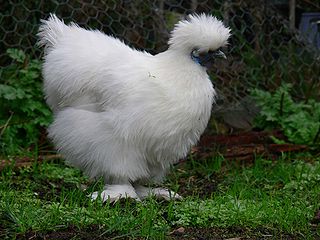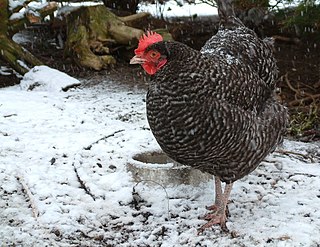

The chicken was a historic Breton breed which had nearly disappeared by the late twentieth century. [1] However, starting in 1988 with a rebreeding effort by the Ecomuseum of Rennes, the breed has since recovered. [2] There is an association of Coucou de Rennes chicken producers that has breeding regulations. These state that the minimum age of slaughter must not be before 130 days for the pullet, 180 days for the hens and roosters, and 200 days for the capons. [1]
The breed is classed as heavy and rare by the Rare Poultry Society. [3] Their eggs are of a cream and tinted nature. [3]
The Ecomuseum in Rennes (Écomusée de la Bintinais) cares for a flock of the breed. [4]
In 2015, a dozen of producers make around 25000 Coucou every year [5] .

Debeaking, beak trimming, or beak conditioning is the partial removal of the beak of poultry, especially layer hens and turkeys although it may also be performed on quail and ducks. Most commonly, the beak is shortened permanently, although regrowth can occur. The trimmed lower beak is somewhat longer than the upper beak. A similar but separate practice, usually performed by an avian veterinarian or an experienced birdkeeper, involves clipping, filing or sanding the beaks of captive birds for health purposes – in order to correct or temporarily alleviate overgrowths or deformities and better allow the bird to go about its normal feeding and preening activities. Amongst raptor-keepers, this practice is commonly known as "coping".

The Silkie is a breed of chicken named for its atypically fluffy plumage, which is said to feel like silk and satin. The breed has several other unusual qualities, such as black skin and bones, blue earlobes, and five toes on each foot, whereas most chickens only have four. They are often exhibited in poultry shows, and also appear in various colors. In addition to their distinctive physical characteristics, Silkies are well known for their calm, friendly temperament. It is among the most docile of poultry. Hens are also exceptionally broody, and care for young well. Although they are fair layers themselves, laying only about three eggs a week, they are commonly used to hatch eggs from other breeds and bird species due to their broody nature.

The La Flèche, French: Poule de La Flèche, is a rare French breed of dual-purpose domestic chicken. It originates from the département of the Sarthe, in the Pays de la Loire region, and is named for the town and commune of La Flèche in that area, not far from the capital of the Sarthe, Le Mans. The breed was once famous for the fine quality of its meat; since the Second World War, numbers have fallen very low.

Chick culling or unwanted chick killing is the process of separating and killing unwanted chicks for which the intensive animal farming industry has no use. It occurs in all industrialised egg production, whether free range, organic, or battery cage. However, some certified pasture-raised egg farms are taking steps to eliminate the practice entirely. Worldwide, around 7 billion male chicks are culled each year in the egg industry. Because male chickens do not lay eggs and only those in breeding programmes are required to fertilise eggs, they are considered redundant to the egg-laying industry and are usually killed shortly after being sexed, which occurs just days after they are conceived or after they hatch. Some methods of culling that do not involve anaesthetics include: cervical dislocation, asphyxiation by carbon dioxide, and maceration using a high-speed grinder. Maceration is the primary method in the United States. Maceration is often a preferred method over carbon dioxide asphyxiation in western countries as it is often considered as "more humane" due to the deaths occurring immediately or within a second.

The Marans, French: Poule de Marans, is a French breed of dual-purpose chicken, reared both for meat and for its dark brown eggs. It originated in or near the port town of Marans, in the département of Charente-Maritime, in the Nouvelle-Aquitaine region of south-western France.

The poulet de Bresse or volaille de Bresse is a French chicken product which has appellation d'origine contrôlée status, and which was registered as a Protected Designation of Origin under EU and UK law as Volaille de Bresse / Poulet de Bresse / Poularde de Bresse / Chapon de Bresse. It may be produced only from white chickens of the Bresse Gauloise breed raised within a legally-defined area of the historic region and former province of Bresse, in eastern France.

The Norfolk Grey is a utility breed of chicken that originated near the city of Norwich, in Norfolk, England, in around 1910. The breed was originally created by Frederick W Myhill of Hethel, Wymondham under the name Black Maria. It is a rare breed which is currently considered to be at risk by the Rare Breeds Survival Trust.

The Legbar is a rare British auto-sexing breed of chicken. It was created in the early twentieth century by Reginald Crundall Punnett and Michael Pease at the Genetical Institute of Cambridge University. They cross-bred American barred Plymouth Rock birds with brown Leghorns and created the gold and silver colour varieties. Pease created a cream Legbar by cross-breeding these with white Leghorns; later crossing with Araucanas caused this to have a crest and to lay blue or blue-green eggs.

The Sebright is a British breed of bantam chicken. It is a true bantam – a miniature bird with no corresponding large version – and is one of the oldest recorded British bantam breeds. It is named after Sir John Saunders Sebright, who created it as an ornamental breed by selective breeding in the early nineteenth century.

The Campine is a breed of domestic chicken originating in the northern part of Belgium. It is named for the Campine region of north-eastern Belgium and south-eastern Netherlands. It was known there as the Kempisch Hoen.

The Houdan or Poule de Houdan is an old French breed of domestic chicken. It is named for its area of origin, the commune of Houdan, in the département of Yvelines to the west of Paris. It belongs to the crested chicken group, is muffed and bearded, has an unusual leaf-shaped comb, and has five toes on each foot rather than the usual four.

The Crèvecœur is an endangered historic breed of crested chicken from the Pays d'Auge, in the Calvados département of Normandy, in north-western France. It is named after the commune of Crèvecœur-en-Auge. It is related to the La Flèche and to other Norman breeds such as the Caumont and Caux and the extinct Pavilly; the Merlerault was formerly considered a sub-type of the Crèvecœur.

The Chantecler is a breed of chicken originating in Canada. The Chantecler was developed in the early 20th century, at the Abbey of Notre-Dame du Lac in Oka, Quebec. It is extremely cold-resistant, and is suitable for both egg and meat production.

The Barbu de Watermael, Dutch: Watermaalse Baardkriel, is a Belgian breed of bantam chicken. It originated in the Belgian town of Watermael-Boitsfort, from which it takes its name, which means "bearded [chicken] from Watermael". It is closely related to the Barbu d'Anvers, but is distinguished from it by its small, backswept crest of feathers. The Barbu de Boitsfort is a rumpless variation, the only difference being that it lacks the uropygium, the part of the anatomy that carries the tail.

Poultry farming is a part of the United States's agricultural economy.
The Modern Langshan is a breed of chicken derived from the Croad Langshan. Though today it is rarely seen, the breed was at one time fairly popular.

Antoine Westermann is a French chef born in 1949 in the Alsatian town of Wissembourg, on the northeast border of France.
The Pictave is an endangered French breed of bantam chicken. It is named for the Pictavi, the tribe which gave its name to the former Province of Poitou, now part of the region of Nouvelle-Aquitaine. It is a true bantam, and has no full-sized counterpart; it is the only true bantam of France. Cocks weigh about 800 grams and hens about 600 g. It was created in the twentieth century by Raymond Lecointre, who used the hens to incubate his pheasant eggs and raise the chicks.
The Coucou des Flandres, Dutch: Vlaamse Koekoek, is a critically-endangered Belgian breed of domestic chicken. It may have a common origin with the Malines from the area of Mechelen, in the province of Antwerp in Flanders, or may indeed represent the original type of that breed before it was cross-bred in the nineteenth century with various different types of imported Oriental chicken. By the time of the First World War it had disappeared; it was re-created in the years before the Second World War. It is critically endangered in Belgium, but more numerous in Picardy in France. It may also be known as the Poulet de Dendre, for the Dender river in its area of origin.